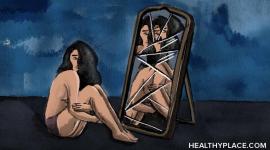Body Dysmorphic Disorder Treatment: Therapy, Medications

Body dysmorphic disorder treatment involves both cognitive behavioral therapy (CBT) and medications as first-line treatment approaches, according to Sabine Wilhelm, Ph.D., a fellow in the OCD Program at Massachusetts General Hospital. BDD reaches beyond mere vanity or self-centered attention to appearance. (What is body dysmorphic disorder?) Despite misconceptions about BDD, it's a very real body image disorder, affecting both men and women.
Body Dysmorphic Disorder Treatment
While effective body dysmorphic disorder treatment protocols exist, the condition can present a challenge to doctors and therapists. For example, some people suffering from BDD truly believe their perceived flaws and defects appear grossly abnormal. These people may not see how BDD treatment can help them, since they think their flaw or defect is real and contributes to their ugliness. In this case, treatment may take longer, but it can still provide effective relief - eventually.
The treatment for body dysmorphic disorder involves two primary approaches:
- Cognitive Behavioral Therapy
- Medications (i.e. selective serotonin reuptake inhibitors – SSRIs)
These two approaches are most often used in combination to treat the symptoms of body dysmorphic disorder. (If you're still wondering, "Do I Have BDD?", take our free online body dysmorphic disorder test.) Take a closer look at the two approaches used in treatment for body dysmorphic disorder:
Cognitive Behavioral Therapy (CBT) – CBT for body dysmorphic treatment focuses on the present and involves goal-oriented therapy. The main goal involves reducing a person's negative thoughts about his or her appearance and the resulting compulsive behaviors. The therapist teaches patients healthy behaviors and how to avoid obsessive behaviors, such as skin picking or mirror checking. Patients learn to restructure their obsessive negative thoughts about their appearance to reflect a more realistic thought pattern. Therapists do this by teaching the patient to evaluate actual evidence for their negative beliefs about appearance or perceived flaws. Challenging the patient's distorted thought patterns illustrates that the thinking is inaccurate, excessive, and not helpful.
People with BDD often believe others are thinking negatively about their appearance and noticing their flaws. This involves an assumption that the BDD patient knows the thoughts of others – mind reading. The therapist will challenge the patient's rationale for believing they somehow know the thoughts of others.
Last, using exposure and response prevention techniques, doctors encourage patients to refrain from their compulsive behaviors when they start to have anxiety based on their negative thoughts about appearance. The patient uses thought restructuring while refraining from mirror checking or other ritualistic acts until the anxiety passes.
Medication – As with other types of obsessive-compulsive disorders, the SSRI class of medications are highly effective in BDD treatment. These medications are prescribed as antidepressants but also work in treating OCD. Some examples of SSRIs prescribed in the treatment for body dysmorphic disorder include:
- Prozac
- Paxil
- Celexa
- Lexapro
- Zoloft
- Anafranil,
- Luvox
You can find a complete list of antidepressant medications here.
These SSRIs work effectively and typically come with very mild side effects. Other antidepressants haven't proved as effective in BDD treatment, but doctors sometimes prescribe them along with SSRIs because they work well to reduce obsessive thinking. Physicians and mental health professionals will also frequently advise patients with BDD to join one of the body dysmorphic disorder support groups in the community. Talking with others who have similar experiences can help people with BDD feel less alone and isolated.
Coexisting Conditions and Body Dysmorphic Disorder Treatment
Other coexisting mental health conditions can complicate body dysmorphic disorder treatment. Research shows that over 75 percent of those with BDD also experience episodes of major depressive disorder at some point in their lives. About 36 percent of people with BDD also have agoraphobia.
Still others have an eating disorder that further complicates BDD treatment effectiveness. It's critical that the mental health professional have the experience and ability to discern the presence of more than one disorder and knowledge about treating coexisting mental health conditions. The doctor may need to treat the coexisting disorder first and treat the BDD once that condition is under control.
Many of the common coexisting disorders require different treatment approaches – another reason that finding an experienced mental health physician is vital.
APA Reference
Gluck, S.
(2022, January 10). Body Dysmorphic Disorder Treatment: Therapy, Medications, HealthyPlace. Retrieved
on 2024, April 16 from https://www.healthyplace.com/ocd-related-disorders/body-dysmorphic-disorder/body-dysmorphic-disorder-treatment-therapy-medications



